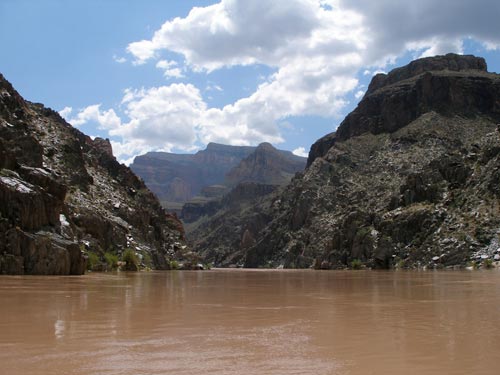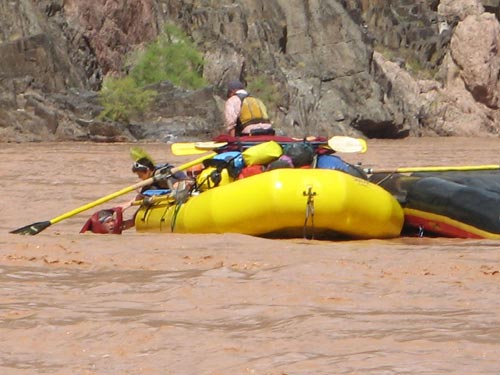The canyon walls weren't as steep here, so the sun began to heat things up even earlier than usual.

For some people, it's simply too hot to bother with a tent. They'd much rather take their chances with the scorpions!
Granite Rapid (mile 93.4) is one of the more difficult rapids (a 7-8 on the scale). It has an 18-foot drop and a strong pull to the wall on river right.
Major John Wesley Powell featured a drawing of his boats running what he called Granite Falls in his fictionalized account of his first river trip in 1869. Bill Belknap made the drawing well-known by featuring it on the cover his popular waterproof river guide.

The waves may not look all that big from here...

... but they certainly do once you are in them!

The kayakers always went before the rafts did.
We all made it through unscathed and enjoyed the short break before the next big one.


Some say that Hermit Rapid (at mile 94.9) is the most frightening 200 yards on the river. At a 7-8 on the rapids scale with a 15-foot drop, it has the strongest hydraulics and biggest waves in the canyon. The Colorado is pushing a lot of water through a relatively narrow canyon.
In 1997, a flash flood changed the rapid... making it even harder. It's now a series of five waves, each one bigger than the previous one, with the last one easily reaching 20 feet high. The flood also removed the 'cheat route' along the left side of the waves.
It was quite an invigorating run... we spun around and ended up going backwards! Suffice to say we got quite wet. One of the rafts flipped but fortunately no one was hurt and almost everything was recovered (all that appeared to be lost was a hat and sun umbrella).

Recovering after the flip

It only took a few minutes to flip the raft back over and continue on our way.
Crystal Rapid at mile 98.2 is a 7-10 on the scale. In the early days, it was barely even noteworthy. A 1923 expedition recorded the 16-foot drop as “the waves are high but the fall is distributed over about one-third mile, so it is easy to run.” A giant storm in December 1966 changed all that. Debris flow constricted the river by about 80% and increased its drop. It became the most-feared rapid on the river. In 1983, the National Park Service asked passengers to walk around it due to excessive summer runoffs. Surprisingly, a controlled flood in 1996 cleared away large portion of the debris fan. It is still, however, a formidable rapid with a dangerous rock garden at bottom on river left.
We took our time scouting it.

Everyone has something to say about it.


A monster wave



We all made it through ok. Actually, our run was so perfect that we barely even got wet! There are still more rapids to come, but the worst for today is behind us. Time for some peaceful floating down to the next campsite. Thunder echoed through the canyon... warning of the upcoming strorm.


This is one of a series of rapids known as the Jewel or Gem Rapids. They include Agate (3), Sapphire (7), Turquoise (3), Emerald (5), Ruby (5) and Serpentine Rapids (7).


Sculpted rocks



Distinctive bands of color are a trip back through geological time.
The Kaibab Formation is a cream-colored, weather-resistant limestone rock layer that caps much of the Grand Canyon rim. It was laid down in the early Permian.

Yup, here it is again (since you probably didn't memorize it).



Cliff prefers his bimini.
Shortly after one of our last rapids, the storm hit. Rain poured down and wind whipped the water into a frenzy. It settled down a bit and continued to rain until we arrived at Bass camp in the afternoon. There was enough time for a hike in Shinumo canyon to look for an old mining camp.
Shinumo Canyon, carved into the Shinumo Plateau, is the largest of all canyon systems in Grand Canyon and contains many other canyons. There is no easy trail along the creek and frequent (somewhat wet) crossings are necessary.
The remains of Shinumo Camp (which we unfortunately didn't find) give tribute to one of the region's pioneers: William Wallace Bass (1849-1933). Eventually the creek ties into the North Bass Trail.

It's a steep hike up from the river.

Possibly an old agave roasting pit

The Side-blotched Lizard, with its distinctive rough tail, is one of the most abundant and commonly observed lizards in the deserts of western North America.


A look down at Shinumo Creek


This is a trail?

One of the many crossings of Shinumo Creek. It was nice to be able to bathe a bit in the cool, clear water instead of the frigid, skin-drying water of the river.


The sun begins to set over the Colorado River.

A top view of the campsite
We made it back in time for dinner. Normally people have a big ABC party (Alive Beyond Crystal)... but I think we were all just too tired! A few of us did end up talking until the wee hours of the morning though. Overhead the sky was filled with shooting stars.
return • continue

